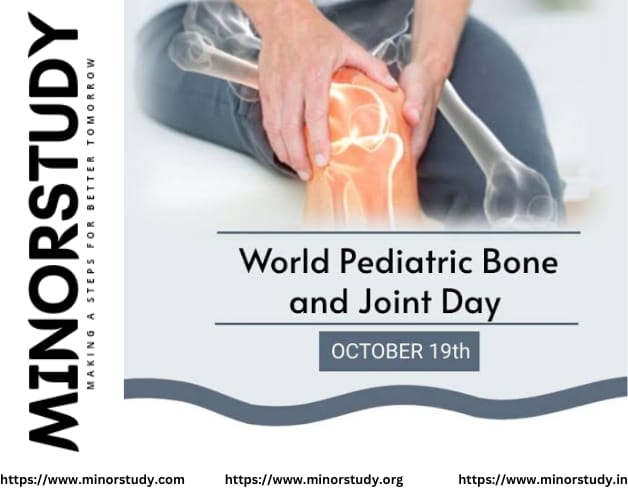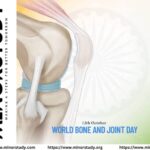👶🦴 World Pediatric Bone and Joint Day: Building Stronger Futures for Children, One Step at a Time
World Pediatric Bone and Joint Day: Every leap, every tumble, every tiny stretch — in a child’s world, movement is growth. Behind those actions are the often-overlooked bones and joints that enable kids to explore, play, learn, and thrive. But what happens when musculoskeletal conditions limit that freedom?
That’s where World Pediatric Bone and Joint Day steps in — a global initiative that raises awareness about bone and joint disorders in children, emphasizing early diagnosis, preventive care, and family support.
This day is more than just a date — it’s a global commitment to children’s mobility, health, and happiness.
🏛️ History of World Pediatric Bone and Joint Day
World Pediatric Bone and Joint Day is observed annually on October 19, as part of the larger Bone and Joint Action Week (October 12–20), recognized globally by organizations such as the United States Bone and Joint Initiative (USBJI).
It was launched in 2012 to bring pediatric musculoskeletal health into the global spotlight. The day aims to educate parents, schools, and medical communities about the early signs of musculoskeletal conditions and the importance of proper posture, physical activity, and timely treatment in childhood.
Why It Was Needed:
-
Bone and joint problems in kids are underdiagnosed and often dismissed as “growing pains.”
-
Early interventions can prevent lifelong disabilities.
-
Childhood is the foundation for lifelong skeletal strength.
📅 Timeline of Key Events
| Year | Event |
|---|---|
| 2000 | WHO declares the Bone and Joint Decade (2000–2010) |
| 2012 | World Pediatric Bone and Joint Day launched by USBJI |
| 2013–Present | Annual observance with pediatric awareness themes |
| 2020 | Posture education campaigns in schools rise |
| 2023 | Tele-orthopedics and pediatric physiotherapy gain momentum globally |
📊 7 Inspiring Facts About Pediatric Bone and Joint Health
-
Children’s bones are more flexible but more prone to growth-related issues
Their bones bend more easily but can develop deformities if not properly cared for. -
Over 10 million children worldwide suffer from musculoskeletal disorders
Including scoliosis, juvenile arthritis, limb length discrepancy, and flat feet. -
Poor posture and screen time are modern skeletal threats
Slouched sitting, heavy school bags, and smartphones are causing “tech-neck” and spine issues early in life. -
Vitamin D deficiency is alarmingly common in children
It leads to weakened bones, rickets, and delayed motor milestones. -
Juvenile idiopathic arthritis affects 1 in 1000 children
A painful, chronic condition that can severely limit movement without early intervention. -
Early treatment has a 90% success rate
Many pediatric bone conditions can be corrected or minimized with physiotherapy or orthopedic care. -
A healthy childhood posture determines future back and joint health
The habits formed in school-age years often last into adulthood.
❓ Frequently Asked Questions (FAQs)
Q1: What is World Pediatric Bone and Joint Day?
It’s a global awareness day observed on October 19, focusing on the musculoskeletal health of children and adolescents.
Q2: Who organizes it?
The day is promoted by the United States Bone and Joint Initiative and supported globally by pediatric orthopedics societies and child health organizations.
Q3: What is its goal?
To educate parents, educators, and health workers about childhood orthopedic conditions and the importance of early intervention.
Q4: What conditions are commonly addressed?
-
Scoliosis
-
Rickets
-
Clubfoot
-
Juvenile arthritis
-
Postural deformities
-
Flat feet
-
Hip dysplasia
Q5: How can parents observe this day?
-
Ensure kids have proper posture during study/play
-
Get regular orthopedic checkups if concerned
-
Educate children about healthy movement
-
Limit sedentary screen time
🌍 Global and Local Significance
1. Protecting the Future Generation
Children with untreated orthopedic issues may face lifelong mobility problems, mental health struggles, and reduced independence.
2. Bridging the Awareness Gap
In developing nations, orthopedic issues are rarely detected early in children due to lack of resources or awareness.
3. Reduces Long-Term Healthcare Burden
Early treatment reduces the risk of costly surgeries and chronic pain later in life.
4. Improves Academic and Social Engagement
Kids free from pain or physical limitations participate better in sports, academics, and social life.
🎉 Observance and Activities on World Pediatric Bone and Joint Day
Organizations across the world celebrate the day with:
-
School-based posture awareness workshops
-
Free screening camps for children
-
Interactive seminars for parents and teachers
-
Online challenges promoting physical activity
-
Pediatric orthopedic consultations and webinars
Some Notable Campaign Themes:
-
“Growing Strong, Standing Tall”
-
“Healthy Joints Start Young”
-
“Catch It Early, Correct It Fully”
-
“Posture is Power for the Playground and Beyond”
💬 Wishing Messages for World Pediatric Bone and Joint Day
Let’s take this moment to express good wishes and encouragement:
🌟 “On World Pediatric Bone and Joint Day, let’s pledge to nurture strong, healthy, and active children — because every child deserves to run, jump, and grow without limits!”
🙌 “To all pediatric orthopedic doctors, physiotherapists, and caregivers — thank you for helping our children walk toward a better tomorrow.”
🧠 Important Points to Remember
-
Pediatric bone health affects lifelong mobility and confidence.
-
Posture education, especially in digital screen time era, is vital.
-
Parents, teachers, and pediatricians play a crucial role in early detection.
-
Active kids are happier, healthier, and smarter — movement supports brain function too.
👨👩👧👦 Why It’s Important in Our Life and Society
In Our Daily Life:
-
Bone issues in children disrupt family dynamics and can cause school absenteeism.
-
Emotional health suffers when a child feels “different” due to physical limitations.
-
Treating bone and joint issues boosts a child’s self-esteem, social life, and cognitive development.
In Society:
-
A physically capable youth population builds a stronger, more productive future.
-
Disability prevention in childhood reduces the future medical and economic burden on society.
-
Spreading awareness supports equity in healthcare, especially for underprivileged children.
💡 Conclusion: Movement Is the Right of Every Child
World Pediatric Bone and Joint Day is a heartfelt reminder: kids aren’t just mini-adults — they’re growing, developing beings who need special orthopedic attention.
From their first steps to their teen sports tournaments, their skeletal health defines how they live and feel. And when something goes wrong, early attention can make all the difference.
Let’s not ignore the warning signs. Let’s empower our children to move freely, grow confidently, and live actively.
🎗️ This October 19, talk to a pediatrician, share educational content, or simply adjust your child’s backpack. The little steps you take now will lead to lifelong movement, joy, and strength.







